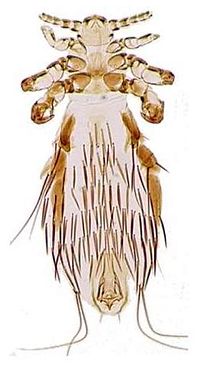Louse
- For other uses, see Louse (disambiguation).
- "Lice" redirects here.
| Phthiraptera | ||||||||||||
|---|---|---|---|---|---|---|---|---|---|---|---|---|
 Light micrograph of Fahrenholzia pinnata
| ||||||||||||
| Scientific classification | ||||||||||||
| ||||||||||||
|
Anoplura |
Lice (singular: louse), (order Phthiraptera), also known as fly babies, are an order of over 3,000 species of wingless insects; three of which are classified as human disease agents. They are obligate ectoparasites of every avian and most mammalian orders. They are not found on Monotremes (the platypus and the echidnas or spiny anteaters) and a few eutherian orders, namely the bats (Chiroptera), whales, dolphins and porpoises (Cetacea) and pangolins (Pholidota).
Description
As lice spend their entire lives on the host, they have developed adaptations which enable them to maintain close contact with the host. These adaptations are reflected in their size (0.5–8 mm), stout legs, and claws which are adapted to cling tightly to hair, fur and feathers, and that they are wingless and dorsoventrally flattened.
Lice feed on skin (epidermal) debris, feather parts, [Chlorine] sebaceous secretions and blood. A louse's color varies from pale beige to dark grey; however, if feeding on blood, it may become considerably darker.
A louse's egg is commonly called a nit. Lice attach their eggs to their host's hair with specialized saliva which results in a bond that is very difficult to separate without specialized products. Living lice eggs tend to be pale white. Dead lice eggs are more yellow. Lice are very annoying and are difficult to remove, but not impossible.
Classification
The order has traditionally been divided into two suborders; the sucking lice (Anoplura) and chewing lice (Mallophaga), however, recent classifications suggest that the Mallophaga are paraphyletic and four suborders are now recognised:
- Anoplura: sucking lice, including head and pubic lice (see also Pediculosis or Head lice)
- Rhyncophthirina: parasites of elephants and warthogs
- Ischnocera: avian lice
- Amblycera: chewing lice, a primitive order of lice
- Amblycera: Jumping Lice have very strong hind legs and can jump a distance of three feet
It has been suggested[attribution needed] that the order is contained by the Troctomorpha suborder of Psocoptera.
Lice and humans
Humans are unique in that they host three different kinds of lice: head lice, body lice (which live mainly in clothing), and pubic lice. The DNA differences between head lice and body lice provide corroborating evidence that humans started wearing clothes at approximately 70,000 B.C.E.[1]
Recent DNA evidence suggests that pubic lice spread to the ancestors of humans approximately 3.3 million years ago from the ancestors of gorillas by sharing the same bed or other communal areas with them, and are more closely related to lice endemic to gorillas than to other lice species infesting humans.[2]
Gallery
Diagram of a louse, by Robert Hooke, 1667.
ReferencesISBN links support NWE through referral fees
- ↑ John Travis (2003-08-23). The naked truth? Lice hint at a recent origin of clothing 164 (8): 118.
- ↑ David L Reed, Jessica E Light, Julie M Allen and Jeremy J Kirchman (2007). Pair of lice lost or parasites regained: the evolutionary history of anthropoid primate lice. BMC Biology 5: 7.
- Integrated Taxonomic Information System (ITIS). 2004. Phthiraptera Haeckel, 1896 ITIS Taxonomic Serial No.: 624282. Retrieved August 14, 2008.
- Integrated Taxonomic Information System (ITIS). 2007. Mallophaga ITIS Taxonomic Serial No.: 103337 . Retrieved August 14, 2008.
See Also
- Pest
- Use of DNA in forensic entomology
External links
- Lice Pest Control Information - National Pesticide Information Center
- Bed-hopping led humans to 3 million-year itch
- www.phthiraptera.org has extensive scientific information.
- body and head lice on the UF / IFAS Featured Creatures Web site
- crab louse on the UF / IFAS Featured Creatures Web site
- WebMD Lice Info
| ||||||||||||||
Credits
New World Encyclopedia writers and editors rewrote and completed the Wikipedia article in accordance with New World Encyclopedia standards. This article abides by terms of the Creative Commons CC-by-sa 3.0 License (CC-by-sa), which may be used and disseminated with proper attribution. Credit is due under the terms of this license that can reference both the New World Encyclopedia contributors and the selfless volunteer contributors of the Wikimedia Foundation. To cite this article click here for a list of acceptable citing formats.The history of earlier contributions by wikipedians is accessible to researchers here:
The history of this article since it was imported to New World Encyclopedia:
Note: Some restrictions may apply to use of individual images which are separately licensed.



